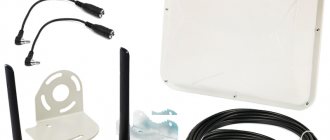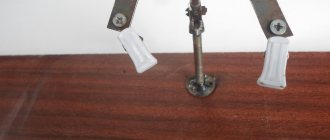How to strengthen the signal of a 3G 4G\LTE USB Modem without an antenna connector
-You can also strengthen the signal in this way - SPF5189Z or we strengthen the 3G\4G signal (LTE)
In order to amplify the base station signal for a USB modem, you need to make an antenna.
And at the same time, when connecting the antenna to the modem, you don’t need to tear out any antennas from the board of the same modem, as they write in many Internet articles, but you will have to use a soldering iron.
Wrapping the central core around the modem is extremely ineffective, one might even consider it useless.
The antenna for wireless networks has proven itself well - GSM, DVB-T2, 3G\LTE, Wi-Fi such as biquadrat, also known as the Kharchenko antenna, figure eight, zigzag (antennas of the same design, sold in stores, as an “amplifier” "3G), works even if it is poorly and imprecisely assembled (bad within reasonable limits).
You need to make an antenna for your own frequency; find out at what frequency your 3G, LTE\4G works on the operator’s websites or on the Internet.
Even for the same regions there may be different frequencies.
Calculate the antenna for the desired frequency on the website:
https://3g-aerial.biz/onlajn-raschety/raschety-antenn/raschet-antenny-kharchenko-zigzagoobraznoj
and collect.
Assembly Notes:
The thickness of the wire can be any, and the gain may slightly change downwards if the thickness is far from the recommended value.
You can take a regular television cable, which has a resistance of 75 Ohms, if you use this - do not forget to choose it when making calculations! There will be less losses on a cable with a resistance of 50 Ohms.
The shorter the cable, the better - there will be less signal attenuation and power loss in the cable.
You can do without a reflector (screen), but with a reflector the signal power increases, it can even increase by several dbi (isotropic decibels).
The reflector is not connected to the cable - neither to the braid nor to the central core!
The reflector can be a CD, a plastic CD box, plywood, a board covered with foil, an aluminum plate - to make the antenna as light as possible.
The distance from the reflector to the antenna can be maintained and used as a support, substrate, stands, such things as a wine cork; plastic tube; plastic tube - for tablets, for solder; cardboard roll - for example from food foil.
Also, the principle that the higher the antenna, the better, may not work here.
Let's look at everything, using the example of the ZTE MF667 3G modem:
Attention! The site administration is not responsible for damage to your property in the event of your incorrect or other actions, everything is done at your own peril and risk.
To remove the wires from the housing, the following holes had to be cut in the housing:
We disassemble the modem and remove the board:
The pad and piece of hardware number 1 is the internal antenna that is being removed, we will do it differently, without tearing out or removing anything:
You will need a low-power soldering iron and a thin wire of solder (or even better and easier - solder paste), throw a drop of solder-jumper on contacts number 2 and 3 (these contacts on the antenna are all connected to each other) to make it easier to solder the wire. Do not overheat the board and do not short-circuit other contacts on the board, the contacts are very small, proceed with caution!
We threw a solder jumper and soldered the wire in this place. The wire needs to be thin in order to pass through the cut holes in the housing and so that the housing snaps and closes. This wire clings to the central core of the cable.
The cable braid clings to the ground - pin 4, solder the second wire here, pin 4 and screen 5 - they call each other, since this is the ground.
Solder the wires well so that they do not come off with a little force, otherwise when assembling the case they may come off, this may not be noticed and therefore there will be no gain.
Now that the wires are soldered and the case is assembled, even these protruding wires act as a small external antenna. Now, in order for the signal to become more powerful, you need to connect a ready-made antenna, made according to calculations for its frequency. The cable braid clings to the modem screen (under the number 4), the central core of the cable is connected to the contact of the internal antenna (under the number 1). The antenna for 3G must be polarized (placed) vertically, i.e. so that it resembles the number 8, and not the infinity sign.
It is important to point the antenna towards the base station!
For verification, convenience and monitoring of the signal in real time, the SibModem program was written:
(NET Framework 4.5 is required to run the program)
Download:
SibModem
If the program writes that no modem was found, this means that the ports could be occupied by other programs and they need to be closed in order to free up the ports. The ports can also be occupied by a standard program for connecting to the Internet that came with the modem.
If the reasons are different, you can select the port manually, but you must run the program through the file - Run without searching for ports.bat
Open tab - AT panel
You can determine existing ports by clicking the corresponding button (In this case, ports are not selected from the drop-down list!)
In order to select a port in the box under the inscription “enter the port manually” you need to write the port number and click OK.
If a port is selected, its number will be written next to the “Selected port:” text at the top of the window.
After auto or manual selection, data on the modem signal strength will be displayed on the “Home” tab
in four formats:
In percentages
In isotropic decibels (-dbi) - the lower the isotropic decibels, the stronger the signal!
CSQ - signal in the native dimension for the modem
And in the usual stick antennas
If the signal is sufficient to load at least something, but slowly, then the DBI inscription will turn yellow; if the signal strength is not enough for more or less normal work with the Internet or the Internet works only occasionally, then the inscription will turn red; if the signal is more or less good, the inscription will turn green.
There, on the “Home” tab there is a window for selecting the data update speed
By default, the update rate is once every 5000 milliseconds (every 5 seconds), and by default the number 250 ms is entered in the window, you can select any digital value, then click Ok
On many modems, entering less than 100 milliseconds does not make sense, since the hardware itself often updates its data at a slower time.
Tests, with and without antenna:
Without antenna, signal level -75 dbi:
We connect the modem to the antenna, the signal rose to -69 dbi, by -6 dbi, which is very good (reminder - the antenna must be pointed at the BS, only then the signal strength will increase):
Let's take a speed test on the famous site speedtest.net
Results without antenna:
The result with the antenna, the speed increase is 2 times impressive:
How to determine your data transfer speed?
Modem speed can be easily determined using special online tests. You will need a computer, browser and Internet access.
The resource https://speed.yorest.ru/ is considered one of the simplest. Its operating principle is that you download a small file, and at the same time the site analyzes the data transfer speed. Here you can independently select testing parameters and the size of the control packet (200 KB, 1000 KB, 3 MB). It is best to focus on the largest document. The test takes longer, but its results are much more accurate.
A popular worldwide resource for testing Internet speed is https://www.speedtest.net. By the way, its interface is the most attractive and informative. When you enter this site, the nearest test server is automatically selected, which speeds up the procedure and has a positive effect on the accuracy of the results. When testing the data transfer speed on a 3G or 4G modem, be prepared for about 20 MB to be taken away from your traffic.
This online service displays not only the speed of transmission and reception of information, but also analyzes ping. This value is displayed in milliseconds and shows the server's response time to your request. Ping is a fairly important indicator. Especially if you use programs like Skype or like online games.
If, using such tests, it is revealed that the speed of data transmission and reception is less than 80% of that stated in the contract with the provider, then you need to contact support. If the speed fully corresponds to the promised indicators, but working with web pages seems painfully long to you, then you should think about a more expensive tariff.
How to find out your base station?
The problem of constant interruptions in the operation of a 3G or 4G modem is most often associated with a weak signal level. Some users identify the cause of low Internet speed in a simple way. If the data transfer speed is constantly low, regardless of the time of day, then the reason is the distance from the tower. If the speed improves at night and in the morning, then this is an overload of the base station (BS).
Basically, a poor 3G or 4G signal is associated with a large distance from the BS to the user. Therefore, it is important to find out its position, which will allow you to make special amplifiers or simply place the modem in that part of the room that is as close as possible to the BS. Advanced users, knowing the numbers of various BSs, will be able to configure the modem so that it connects not only to the nearest tower, but also to the one that has more free radio channels, thereby significantly improving the speed of the Internet connection.
The online resource https://cellidfinder.com will help you find your BS. You only need to know 4 parameters:
- The operator's country code (MCC). For Russia it is equal to 250.
- The unique code of the operator itself, called MNC (Mobile Network Code).
- Local Area Code or LAC. This is a kind of unification of several base stations within one territory, which are serviced by one controller.
- The last parameter is CellID (CID). This is the identification number of the sector where the BS is located.
How can you find out all these parameters? To do this, you can use the Netmonitor application or the web resource of the same name. By the way, on this site you can find a map where the majority of BSs in the central part of Russia, owned by the most popular telecom operators, are presented.
We find out all the necessary values through the netmonitor and enter them in a special search window on the main page of https://cellidfinder.com. Next, check the boxes next to “Google data”, “Yandex data” and “Averaging”. Thus, the accuracy of determining coordinates increases. Click the “Find” button. We look at the marked places on the map with the location of the BS.



